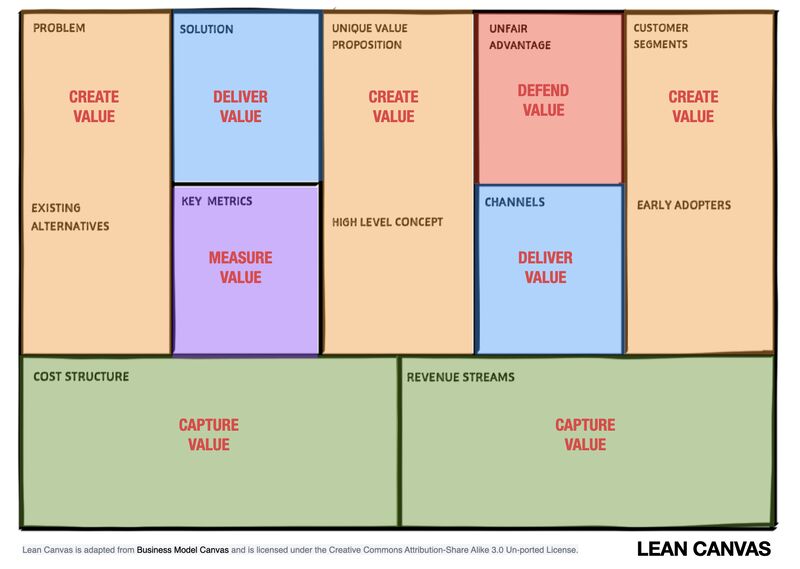When small and mid-sized business owners think about scaling, conversations often revolve around marketing, revenue, or even funding. But behind every sustainably scalable business lies something less flashy and far more foundational: the business model.
If you’re asking “which should be included in a firm’s business model,” you’re already ahead of the curve. But to gain true clarity and traction, it’s time to go beyond vague strategy documents or traditional business plans.
In this blog post, we explore the Lean Canvas framework, why it’s better suited for growing firms than the original Business Model Canvas, and how you can use it to build a model that reflects real-world execution, not just theory.

The Importance of a Business Model
A business model serves as a blueprint for how your company creates, delivers, and captures value.
It outlines the core aspects of your operations, including your target customers, value proposition, revenue streams, and cost structure.
By having a clear and comprehensive business model, you can make informed decisions, attract investors, and ensure long-term growth.
The Original Business Model Canvas
The original business model canvas, created by Alexander Osterwalder, is widely used by startups and large organizations alike. It consists of nine components that comprehensively describe how a business operates.
- Customer Segments: Different groups of people or organizations that your business aims to serve.
- Value Proposition: The unique value or solution your business offers to meet customer needs.
- Channels: The various ways through which your business delivers its value proposition to customers.
- Customer Relationships: The types of relationships your business establishes with different customer segments.
- Revenue Streams: The various ways your business generates income from each customer segment.
- Key Resources: The assets required to make your business model work.
- Key Activities: The most important actions your business must take to deliver its value proposition.
- Key Partnerships: The external organizations or individuals that your business relies on to operate.
- Cost Structure: The significant costs involved in operating your business.
While the original business model canvas is comprehensive, it can be too complex for small to mid-sized businesses. This is where the Lean Canvas framework comes in.
Why the Lean Canvas is a Better Fit for Growth-Minded Firms
The original Business Model Canvas is a great high-level tool for capturing how your company creates and delivers value. While it’s useful for large organizations or for understanding the big picture, it doesn’t always reflect small to mid-sized businesses’ dynamic and evolving nature.
That’s where the Lean Canvas, created by Ash Maurya, becomes essential.
The Lean Canvas is designed for speed, adaptability, and practicality. It focuses on problems, solutions, and metrics that matter during growth stages. It doesn’t just ask you to document what your business is. It forces you to question whether it actually works.
The Lean Canvas is particularly valuable for small to mid-sized businesses because it simplifies the process of developing a business model. It helps you focus on the most critical aspects of your business, making it easier to understand and implement.
Here are some reasons why you should consider using the Lean Canvas:
- Simplicity: The Lean Canvas is designed to be simple and easy to use. It allows you to capture the essence of your business model on a single page, making it easier to communicate and understand.
- Focus on Problems: By emphasizing the problems your business aims to solve, the Lean Canvas helps you develop solutions that address real customer needs. This focus on problems ensures that your business is solving the right issues and your solutions stay relevant as time goes by.
- Actionable Insights: The Lean Canvas provides actionable insights that help you make informed decisions. By identifying key metrics and tracking your progress, you can ensure that your business is on the right track.
- Competitive Advantage The unfair advantage component helps you identify and leverage the unique aspects of your business that set you apart from competitors. This competitive advantage is crucial for long-term success.

The Lean Canvas Framework: 9 Elements Which Should Be Included In A Firm’s Business Model
Developed by Ash Maurya, the Lean Canvas offers a streamlined version of the traditional business model canvas. It focuses on the most critical aspects of a business model, making it easier to understand and implement
The Lean Canvas consists of nine components which should be included in a firm’s business model. It’s similar to the original canvas, but with some key differences.
Here are the nine components of the Lean Canvas, along with why each is critical:
1. Problem
You don’t build a business around a product. You build it around a pain.
Identify the top 1–3 problems your ideal customers face. These aren’t surface-level frustrations but core friction points.
Tip: Use actual language from your customers to define problems. Clarity starts with empathy.
2. Customer Segments
Who exactly are you solving this problem for?
Segment your audience by behavior, urgency, and willingness to pay. Your best clients are those who are both ready and able to act.
Insight: Mid-market leaders often waste energy on audiences who are “interested” but not invested. We help them narrow in on high-converting profiles.
3. Unique Value Proposition (UVP)
This is your one-sentence pitch which should be included in a firm’s business model. What makes your business not just different but worth choosing?
Avoid generic value props. Instead, focus on a clear, quantifiable, and emotionally resonant promise.
Example: “Double profitability in 12 months without burning out their team.”
4. Solution
What is your specific answer to the problem? Break it into your core offers or features.
At Leficomp, this could include:
- Business Assessment
- Energy Leadership Index (ELI) Assessment
- Workshops
Best Practice: Build solutions that are modular. Clients evolve; so should your delivery.
5. Channels
How do people find out about you?
Not all marketing channels are equal. Choose the ones that match your audience’s decision-making behavior. For example:
- Executives respond to referrals and LinkedIn thought leadership
- Entrepreneurs engage more through podcasts and webinars
Note: Avoid the trap of doing everything. Double down where you get traction.
6. Revenue Streams
How do you make money? And how could you diversify?
It’s easy to focus on top-line revenue, but percentage and total profitability are what actually fuel your growth. As part of our 4KPI model, we track:
- % Profitability
- Total net profit
- Revenue per team member
Bonus: We use the Profit First framework with our clients to help them manage cash flow and prioritize profit.
7. Cost Structure
What does it cost to operate?
Every firm should be aware of:
- Fixed and variable costs
- Operational bottlenecks that increase the cost-per-delivery
- Underused resources (team, tools, subscriptions)
Mistake to avoid: Over-investing in tools before nailing workflow clarity.
8. Key Metrics
What are the numbers that define success?
This is where the Lean Canvas gets powerful. Every component of the model should be tied to one or more measurable outcomes. For example:
- Leads generated per week
- Close rate by sales channel
- Client retention rate
At Leficomp, our clients track a simplified KPI dashboard to review weekly with their team.
9. Unfair Advantage
What do you have that no one else can copy?
This could be:
- Proprietary frameworks
- Deep niche expertise
- Your network or market positioning
Many business owners skip this, but it’s essential for long-term defensibility.

Practical Tips for Using the Lean Canvas
Here are some practical tips for using the Lean Canvas to develop your business model:
- Start with the Problem: Begin by identifying the top problems your business aims to solve. This will help you develop solutions that address real customer needs.
- Be Specific About Customer Segments: Clearly define the different groups of people or organizations that your business aims to serve. Being specific about who has these problems helps tailor your solutions.
- Develop a Strong Value Proposition: Focus on what makes your solution compelling and different. Your unique value proposition should explain why customers should choose your product or service over competitors.
- Outline Your Solution: Provide a clear description of how your business solves each of the identified problems. This will help you communicate the value of your product or service to customers.
- Identify Key Metrics: Determine the performance indicators that measure your progress. Tracking these metrics will help you make data-driven decisions and ensure that your business is on the right track.
- Leverage Your Unfair Advantage: Identify the unique aspects of your business that competitors cannot easily copy. Leveraging this competitive advantage is crucial for long-term success.
Building a Sustainable Business Model
A well-defined business model is essential for the success of any firm.
By using the Lean Canvas framework, you can create a comprehensive blueprint that guides your business decisions and drives growth.
Whether you are a small startup or a mid-sized business, having a clear understanding of your business model will help you navigate the complexities of the modern business environment.
With the Lean Canvas you have a clear understanding of all the important pieces which should be included in a firm’s business model.
A Business Model That Scales You
Your business model isn’t just about scaling your company. It’s about scaling your energy, your vision, and your impact.
If you’ve been operating on guesswork, scattered offers, or vague market positioning, now is the time to rethink and realign.
Start with a framework that forces clarity. The Lean Canvas is that tool. And with expert guidance, it becomes your launchpad for sustainable, strategic, and profitable growth.
Ready to Build a Business Model That Actually Works?
Our Thrive360 Business Assessment is designed to help you unpack, refine, and align your business model with strategy, systems, and team capacity.
Ready to double your revenue?


